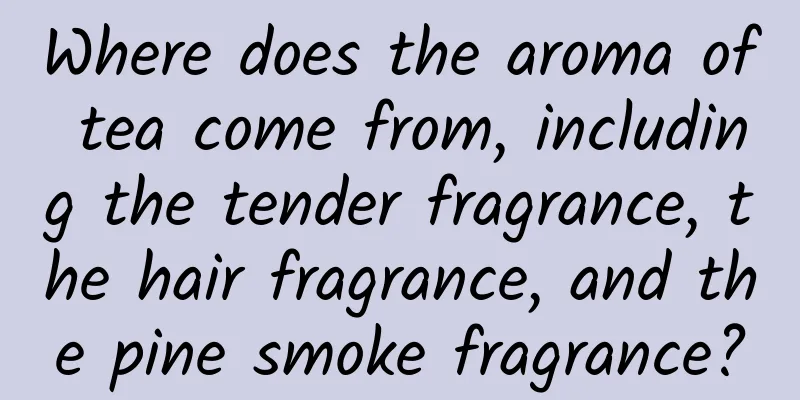Where does the aroma of tea come from, including the tender fragrance, the hair fragrance, and the pine smoke fragrance?

|
The fragrance of plum blossoms comes from the bitter cold, where does the fragrance of tea come from? Some people say that it is the addition of flavors, and some people say that bean-scented tea is grown by drinking soy milk. The more they talk about it, the more mysterious it becomes, and it also casts a layer of mystery over our tea aroma family. As an imported food and the "national drink" of the Chinese nation, we hope to walk in the sun and not become a mysterious figure that cannot be explained. Today, we will bring the tea aroma family to the stage so that everyone can have a positive and clear understanding of us. Figure 1 The fragrant Pu'er tea (Photographed by Wu Qinyao) Our common name is "aroma", and in the field of tea science we are called "aromatic substances", which is the general name for volatile substances in tea. Like tea polyphenols and amino acids, we are the nutritional and functional components of tea, but our absolute content in tea is very small, generally accounting for only 0.02% of the dry matter, but our role should not be underestimated, and it is one of the important factors that determine the quality of tea. After all, whether tea is fragrant or not? It depends on us to blend. We are a huge family. At present, about 700 kinds of tea aromatic substances have been separated and identified, including more than ten categories such as alcohols, aldehydes, ketones, acids, esters, lactones, phenols and their derivatives, heterocyclics, heterooxygen compounds, sulfur compounds and oxygen-containing compounds. The characteristic aroma components and aroma-related components of each type of tea are different. For example, the bean aroma mentioned above is the charm of pyrroles and aldehydes in our family. Figure 2 Relationship between characteristic aroma components and aroma-related components (produced by Wu Qinyao) There are many types of Chinese tea, each with its own unique aroma and complex active ingredients. The bean aroma of Longjing, the orchid aroma of Tieguanyin, the rock-bone flower aroma of Dahongpao, the aged aroma of Pu'er, the hair aroma of white tea... are ever-changing. Generally speaking, the sources of our aroma can be summarized into three types: variety aroma, regional aroma and craft aroma. The aroma of the variety is our innate "precursor aroma", which is imprinted in our genes. For example, the aroma of the main variety of Wuyi rock tea, cinnamon tea, smells "spicy", similar to spices, with a unique cinnamon aroma, while the aroma of narcissus tea is a faint orchid fragrance, noble and elegant. In terms of its internal aroma components, in addition to the cinnamon aroma, the aromatic substances it contains are mainly nerolidol, linalool, ethylenealdehyde, phenylethyl acetate, jasmine lactone and other ingredients. Hexenal is a floral aroma component, with a high content in black tea and oolong tea. Phenylethyl acetate has a fruity aroma, and jasmine lactone has a dry fruit aroma. From the composition of the aromatic substances in cinnamon tea, it can be seen that the presence of floral and fruity aromas in cinnamon is inevitable, but when will cinnamon have floral and fruity aromas? At this time, the concept of "craft fragrance" needs to be introduced. Tea research staff took samples from the processing production line and found that when cinnamon varieties are used to make Wuyi rock tea, "the fermentation is light, the roasting is light, and the cinnamon is more floral; the fermentation is heavy, the roasting is heavy, and the cinnamon is more fruity." This is because cinnamon is a semi-fermented tea, and the aromatic substances in the tea quietly change with the withering, shaking, and static processes: as the fermentation time increases, the aroma of the tea changes from the most primitive grassy aroma to the pleasant tea aroma. If the fermentation time is short and the fermentation degree is low, the aromatic substances contained in the tea are dominated by "floral" aromatic substances. On the contrary, the aromatic substances in the heavily fermented tea will begin to reorganize and influence each other, exuding a "fruity" aroma similar to peaches or ripe nuts. Figure 3 Wuyi rock tea withering and standing (photographed by Lin Cailan) In addition to the fermentation process, the degree of roasting also affects the flavor of rock tea, which can consolidate and enhance the aroma. For Wuyi rock tea, the roasting temperature is low and the time is short, which stimulates low-boiling point aromatic substances, such as orchid, gardenia, lily and other "floral fragrances". Therefore, in addition to the cinnamon fragrance, the lightly roasted cinnamon also has various floral fragrances. On the contrary, if the roasting temperature and time are increased, the low-boiling point aromatic substances of the medium-full roasted cinnamon begin to evaporate gradually, and the high-boiling point aromatic substances with "fruity" or even "milky" aroma begin to appear, which is like an overlapping symphony of tea fragrance, with distinct layers and ups and downs, which attracts tea drinkers to applaud. In short, processing technology is the key to forming different aromatic substances and giving tea leaves different aroma qualities. The aroma precursors are transformed into rich and colorful aromas through enzymatic action and thermochemical reactions during processing. The land and water nurture the people. The same tea leaves, with the same set of genetic codes, grown in different regions may have different aromas. This is the so-called "regional aroma". High mountain clouds and fog produce good tea. The higher the altitude, the thicker the soil layer and the greater the temperature difference between day and night, which is conducive to the accumulation of tea aroma components. The aroma is high and the taste is mellow, so the quality of tea is naturally superior to that of tableland tea. Figure 4 Without the green mountains, how can there be the fragrance of rocks and flowers? (Photo by Lin Cailan) White tea also has a unique aroma, and is known as the "friend of time." One-year-old tea has a unique "honey aroma" and apricot fragrance, three to eight-year-old tea has a lotus leaf fragrance, eight to fifteen-year-old tea has a red date fragrance, and more than fifteen-year-old tea has an amber fragrance. It is a "drinkable antique tea" that everyone is chasing after, with both collection and health benefits. Studies have shown that geraniol, linalool and their oxides II and IV are the characteristic components of the "hair aroma" of new white tea. As time goes by, alcohol compounds are reduced or decomposed to varying degrees, making the freshness and hair aroma of white tea gradually decrease or even disappear, but hydrocarbons, especially olefins, increase to varying degrees. This is the power of time in the storage and aging process of white tea, and it also makes the medicinal value of white tea widely known. There is a saying among the people that "one year of tea, three years of medicine, seven years of treasure". Figure 5 Basic introduction to white tea (made by Huang Fang) In recent years, the physiological effects of aromatic substances have also attracted widespread attention. The main characteristics of jasmine tea are that it contains a large amount of aromatic substances such as benzyl acetate, cis-3-hexenyl benzoate, linalool, methyl benzoate, farnesene, etc. The essential oil content of jasmine tea is dozens of times that of other teas, and some of its components are more than 1,000 times that of other teas. It is widely used in aromatherapy for patients with depression and in the field of home aromatherapy. Tea is the national drink, and we have left our mark in every chapter of Chinese history. I hope everyone can understand me scientifically and rationally, so that the great Chinese tea can benefit more people. |
<<: The State Council's Safety Committee Office reminds you to take precautions →
>>: Who retires satellites? Space tugs!
Recommend
iOS 15 is coming, but Apple still seems to be planning an iOS 14.8 update
According to code discovered in Xcode, Apple appe...
Short video emotional gameplay project, violent monetization to achieve a monthly income of 10,000+
Course Catalog: 1. Emotional projects on TikTok 2...
Fitness apps are actually useless for fitness, except for chatting with each other...
Every fitness app claims that the best mobile coa...
Hummingbird: "I have the same beak as your flower"
In nature, although the hummingbirds and flowers ...
Brand marketing ideas with budgets ranging from 10,000 to 500,000!
Today I will briefly introduce to you the marketi...
Moldy food cannot be eaten, so why can tofu with hair on it be eaten?
Mold varies greatly in appearance The appearance ...
Liyang SEO Training: What methods are needed to achieve a high ranking in website promotion and marketing?
When we usually use a search engine, we will ente...
The beauty of the seasons: Beginning of Autumn丨Is Beginning of Autumn also divided into “early” and “late”?
Xinhua News Agency, Tianjin, August 7 (Reporter Z...
Washing dishes this way increases bacteria by 70 times! All of them are eaten into the stomach...
Many people say that they have a habit at home of...
Are women's periods contagious? The truth may be different from what you think!
There are usually two reasons why menstruation ap...
Only 200 mature individuals left: Guizhou's unique golden snub-nosed monkey is critically endangered
Although the outrageous conversation above may ju...
6 factors that influence banner ad clicks!
Brothers! Sisters! When you browse Taobao, do you...
Unknown light column appears in the night sky of Jeju Island, South Korea! Is it an alien invasion or a celestial wonder?
In the pitch-black night, colorful beams of light...
5 ways to express your ideas in short videos
As a merchant selling goods, when we publish shor...
Foreign online earning projects: once and for all, earn over 100 US dollars a day through pipeline income
Today I will share a foreign online earning proje...









